Configuration elements of the User task type
A configuration element of the User task type is an entity that lets you implement routine operations and execute them in business processes. Learn more about business processes: BPM tools (user documentation). The schema of the User task type configuration element implements the User task process element that lets you select the needed task type. Learn more about the User task element: User task process element (user documentation).
The item of the Add drop-down list in the toolbar of the Configuration section workspace represents the user task schema you can add in Creatio IDE.
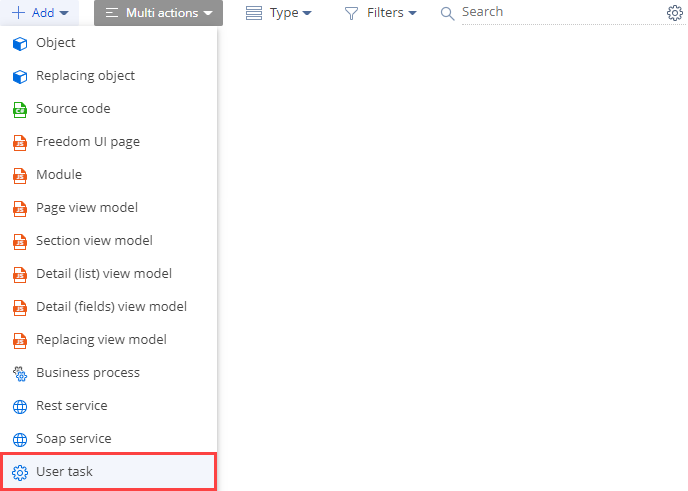
The User task type schema in the Type drop-down list in the toolbar of the Configuration section workspace represents the configuration element of the User task type. A schema is the basis of Creatio configuration.
View the type of the user task schema in the figure below.
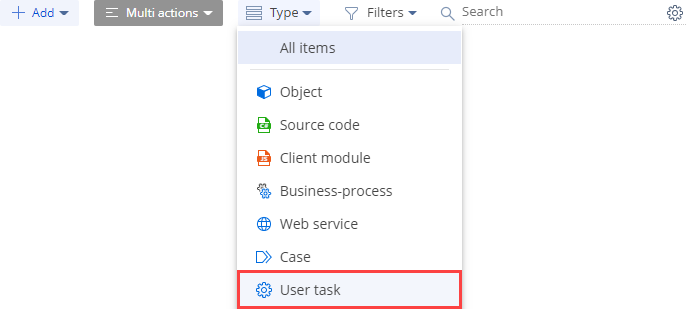
Implement a user task
By default, Creatio includes a set of pre-configured user tasks. Creatio IDE lets you implement a custom user task. In its simple implementation, the user task mechanism is partially similar to the Script task process element. Learn more: Script task process element (user documentation).
Creatio lets you use the implemented custom user task in various business processes. When you change the custom user task, Creatio applies the changes to every business process that contains the task.
To implement a user task:
-
Open the Configuration section. Instructions: Open the Configuration section.
-
Select a user-made package to add the schema.
-
Add a user task schema. To do this, click Add → User task in the section list toolbar. This opens the User Task Designer.

-
Fill out the schema properties.
Property
Property description
Code*
The schema name. Starts with the prefix. Learn more: Manage configuration elements. Can contain Latin characters and digits.
Title*
The localizable schema title. The title of the configuration element schema is generated automatically and matches the value of the Code property without the prefix.
Package*
The user-made package where you create the schema. The property is populated automatically and non-editable.
Description
The localizable schema description.
Parameters edit page
The user task’s parameter setup page. Creatio displays the page when you set up an element in a business process. Create the page before setting up the user task. Otherwise, the list of user task parameters will be displayed.
Dcm parameters edit page
The user task’s parameter setup page. Creatio displays the page when you set up the element in the Case Designer. Create the before settings up the user task. Otherwise, the list of user task parameters will be displayed.
Small vector image
The user task icon in the action menu. Make sure the icon meets the requirements. Read more >>>
Large vector image
The user task icon in the business process schema. Make sure the icon meets the requirements. Read more >>>
Title vector image
The user task icon in the element setup area of the Business Process Designer. Make sure the icon meets the requirements. Read more >>>
Small vector image for DCM
An image that affects the appearance of the user task in the Business Process Designer.

-
Apply the changes.
As a result, Creatio will save the properties of the User task type configuration element. The User Task Designer will close. When you reopen the schema of the User task type configuration element, you will see the C# code generated upon saving in the workspace of the User Task Designer.
If needed, use
 in the properties area to change the schema properties.
in the properties area to change the schema properties. -
Fill out the additional properties (optional). To do this, use
 in the properties area.
in the properties area.The additional schema properties are as follows:
- Localizable strings
- Parameters. User task parameters return the task result. Read more >>>
-
Implement the functionality using the following custom classes:
-
The class that inherits from the
Terrasoft.Core.Process.ProcessUserTaskclass. Learn more: ProcessUserTask class. The purpose of the class is to implement the base user task mechanism. The class matches the Code property of the user task schema.The methods that the User Task Designer lets you replace in the inheritor class of the
ProcessUserTaskclass depend on the user task type. View user task types in the table below.User task type
Description
Replaced methods
Interactive
User or Creatio input is required to complete the user task. Interaction includes entering additional data, selecting a mode, and waiting for the object signal.
InternalExecute()
CompleteExecuting()
CancelExecuting()
Non-interactive
User input is not required to complete the user task.
InternalExecute()
-
The class that inherits from the
Terrasoft.Core.Process.ProcessUserTaskSchemaExtensionclass. Learn more: ProcessUserTaskSchemaExtension class. The purpose of the class is to implement additional capabilities of the user task, for example, parameter synchronization, dependency setup, etc. To create a name of the inheritor class, add aSchemaExtensionsuffix to the name of the user task class. For example, the name of the inheritor class for thePerformHardWorkUserTaskuser task isPerformHardWorkUserTaskSchemaExtension.
-
-
Publish the schema.
Add a user task parameter
-
Click
 in the properties area of the Parameters node’s context menu.
in the properties area of the Parameters node’s context menu. -
Fill out the parameter properties.
Property
Property description
Code*
The parameter name.
Title*
The localizable parameter title.
Type*
The parameter type. Depending on the selected value, you can link the current parameter to other user task parameters.
Lookup
A lookup. The property becomes available if you select "Lookup" in the Type property.
Schema
The name of the schema connected to the parameter. The property is non-editable.
Required
Specifies the parameter is required.
Resulting
Specifies the parameter is resulting, i. e., to enable users to use the values of the current parameter in the condition of a conditional flow.
Contains performer Id
Specifies the ID of the contact who performs the task in the parameter. The property becomes available if you select "Lookup" in the Type property.
Lazy load
Specifies the load the process diagram without delays. If you select the checkbox, Creatio loads the parameter immediately before using it. Learn more about lazy loading: Lazy initialization (Wikipedia).
Serializable
Specifies the save the value of the current parameter as part of the user task execution, i. e., between
InternalExecute()andCompleteExecuting()method calls. Required for interactive user tasks.Copy value
Specifies the enable copying the parameter value when reusing it. The property is deprecated. We do not recommend using it.
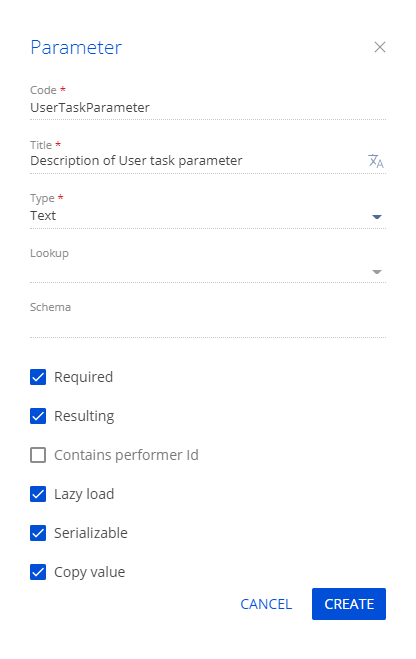
-
Click Create.
To change the parameter properties, use  in the properties area.
in the properties area.
To delete the parameter, use  in the properties area.
in the properties area.
Add a user task to the Process element tab
If you are going to use the custom user task element often, add it to the Process element tab of the Process Designer to streamline the workflow. To do this:
-
Execute the SQL query to the
SysProcessUserTaskdatabase table.- Microsoft SQL
- PostgreSQL
insert into SysProcessUserTask(SysUserTaskSchemaUId, Caption)
select s.UId, s.Caption from SysSchema s
where s.Name = 'UsrSomeProcessUserTask'INSERT INTO "SysProcessUserTask" ("SysUserTaskSchemaUId", "Caption")
VALUES
(
SELECT s."UId", s."Caption" FROM "SysSchema" AS s
WHERE s."Name" = 'UsrSomeProcessUserTask'
)Where
UsrSomeProcessUserTaskis the name (the value of the Code property) of the user task schema. -
Log out from Creatio and log back in or compile Creatio. Instructions: Compile the configuration.
Use hot keys
To display the index of available hot keys:
- Open the User Task Designer.
- Click
 on the toolbar.
on the toolbar.
Hot key | Action |
|---|---|
Ctrl+A | Select all |
Ctrl+Z | Undo |
Shift+Ctrl+Z | Redo |
Ctrl+F | Find |
F3 | Find next |
Shift+F3 | Find previous |
Shift+Ctrl+F | Replace |
Shift+Ctrl+R | Replace all |
Ctrl+Y | Delete line |
Alt+Left | Go to line start |
Alt+Right | Go to line end |
Alt+G | Jump to line |
F11 | Fullscreen code editor |
Esc | Exit fullscreen mode |
Ctrl+Space | Call autocomplete |
Ctrl+S | Save the changes. Available for Creatio 8.0.10 and later. |
Requirements for user task icons
A user task contains the following icon type:
- small vector image
- large vector image
- title vector image
Requirements for small vector images
View example small vector images of out-of-the-box user tasks that meet the requirements below.

The icon structure is as follows.
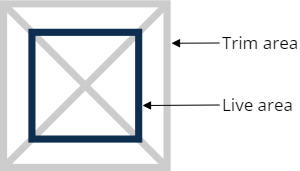
Make sure the custom small vector images meet the following requirements:
-
Format: *.svg.
-
Line width of a trim area: 1 pixel.
-
The small vector image visualizes the functionality of the business process element. The small vector image matches large and title vector images.
-
Do not round the corners of the small vector image.
-
The small vector image detailing matches the other small vector images.
-
Color.
Trim area
Background color: transparent
Live area
#54657D -
Size.
Trim area
24x24 pixels or larger proportionally
Live area
16x16 pixels. Minor details can go beyond the live area.
Requirements for large vector images
View example large vector images of out-of-the-box user tasks that meet the requirements below.

The icon structure is as follows.
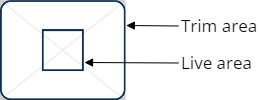
Make sure the custom large vector images meet the following requirements:
-
Format: *.svg.
-
Line width of a trim area: 1 pixel.
-
The large vector image visualizes the functionality of the business process element. The large vector image matches small and title vector images.
-
The large vector image detailing matches the other large vector images.
-
Color.
Trim area
Background color: color from indicated area.
For example, #889CC0, #77C286, #B46DCB, #669AC7, #65BAD3.
For example, #F0C242, #EE7950, #E99535.
Live area
#FFFFFF -
Size.
Trim area
69x55 pixels or larger proportionally
Live area
24x24 pixels. Minor details can go beyond the live area.
-
Corner radius.
Trim area
6 pixels
Live area
1–2 pixels
Requirements for title vector images
View example title vector images of out-of-the-box user tasks that meet the requirements below.

The icon structure is as follows.
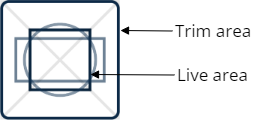
Make sure the custom title vector images meet the following requirements:
-
Format: *.svg.
-
Line width of a trim area: 2 pixels.
-
The live area must be filled.
-
The title vector image visualizes the functionality of the business process element. The title vector image matches small and large vector images.
-
The title vector image detailing matches the other title vector images.
-
Color.
Trim area
Background color: #FFFFFF
Live area
Background color: color from indicated area.
For example, #889CC0, #77C286, #B46DCB, #669AC7, #65BAD3.
For example, #F0C242, #EE7950, #E99535.
-
Size.
Trim area
42x42 pixels or larger proportionally
Live area
22x22 pixels. Minor details can go up to 32 pixels beyond the live area.
-
Corner radius.
Trim area
3 pixels
Live area
1–2 pixels
See also
Resources
BPM tools (user documentation)
Lazy initialization (Wikipedia)

